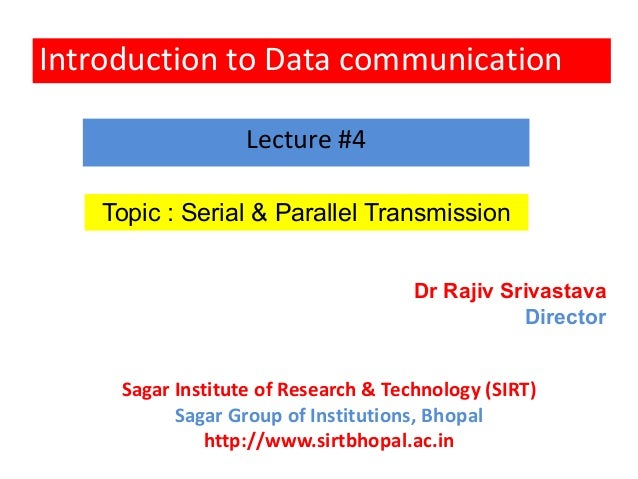
Serial Data Transmission Parallel Data transmission Advantages Disadvantages Advantages Disadvantages Used over long distances Slower to send data Faster than serial.
You cannot formulate it this way. Serial transmission is slower than parallel transmission given the same signal frequency. With a parallel transmission you can transfer one word per cycle (e.g. 1 byte = 8 bits) but with a serial transmission only a fraction of it (e.g.
The reason modern devices use serial transmission is the following: • You cannot increase the signal frequency for a parallel transmission without limit, because, by design, all signals from the transmitter need to arrive at the receiver at the same time. This cannot be guaranteed for high frequencies, as you cannot guarantee that the signal transit time is equal for all signal lines (think of different paths on the mainboard). The higher the frequency, the more tiny differences matter.
Hence the receiver has to wait until all signal lines are settled -- obviously, waiting lowers the transfer rate. • Another good point (from ) is that one needs to consider crosstalk with parallel signal lines. The higher the frequency, the more pronounced crosstalk gets and with it the higher the probability of a corrupted word and the need to retransmit it. 1 So, even if you transfer less data per cycle with a serial transmission, you can go to much higher frequencies which results in a higher net transfer rate. 1 This also explains why (Parallel ATA with increased transfer speed) had twice as many wires as pins.
Every second wire was grounded to reduce crosstalk. @Val You're not reading the whole answer. A Bus moves more people than a car when they go the same speed - but because of the way physics works, these cars can go way faster than a bus, so it is faster to move people by using cars than buses.
The same goes for data links: at the same speed, parallel cables move more data than a serial cable; however, we can push a serial cable to operate much, much faster than we can a parallel cable. If we try to speed up the parallel cable, physics causes the data be become garbage.
For example, the episode of Uddhava going to Vridavan and getting teaching of Bhakti from Gopis actually happened when Krishna was in Mathura (according to Srimad Bhagwad Mahapuran) but was shown in the serial when Krishna was in Dwarka. Search Results of dwarkadhish serial episodes 10. Check all videos related to dwarkadhish serial episodes 10. BR Chopra - TV Serials - B.R. TV 8,683,971 views 19:01 Krishna Sudama Milan - भगवान श्रीकृष्ण ने आंसुओं से धोए सुदामा के. Dwarkadhish serial all episodes.
– Jun 7 '13 at 19:47 •. In fact I see upside down. It is passenger (public) transport that has higher throughtput, because you do not transport the automobile with everybody, though people prefer moving individually, in parallel automobiles and therefore, develop extensive suburbs infrastructure instead of packing people into compact, 3d cities. I see the burst of serial bits as a train. Roughly, sending a packet is expensive but it does not matter how much data you send per packet. It is therefore 1000 times cheaper to send a train of 1000 bits rather than 1000 parallel cars. – Jun 9 '13 at 10:37 •.
Tomb raider congratulations you have successfully installed downloadable conten. The problem is synchronization. When you send in parallel you must measure all of the lines at the exact same moment, as you go faster the size of the window for that moment gets smaller and smaller, eventually it can get so small that some of the wires may still be stabilizing while others are finished before you ran out of time.
By sending in serial you no longer need to worry about all of the lines stabilizing, just one line. And it is more cost efficient to make one line stabilize 10 times faster than to add 10 lines at the same speed. Some things like PCI Express do the best of both worlds, they do a parallel set of serial connections (the 16x port on your motherboard has 16 serial connections). By doing that each line does not need to be in perfect sync with the other lines, just as long as the controller at the other end can reorder the 'packets' of data as they come in using the correct order.
The does a very good explination in depth on how PCI Express in serial can be faster than PCI or PCI-X in parallel. TL;DR Version: It is easier to make a single connection go 16 times faster than 8 connections go 2 times faster once you get to very high frequencies.
Rich Seifert wrote 'Indeed, many people call IEEE 802.11 'Wireless Ethernet'. While this surely flies in the face of any technology argument (it doesn't even use the same frame format as IEEE 802.3), I can live with it when speaking to people to whom the technology difference is unimportant.' The economics of Ethernet are different from buses like SATA — cables are very long and expensive to replace, so you focus on upgrading electronics at the end. Early Ethernet used 1 pair of wires but standardized on 4 pairs cables anticipating future use (at that era parallel was the obvious approach to faster transmission).